
Wine Culture and Information since 2002 - Volume 22
 Wine Culture and Information since 2002 - Volume 22 |
|
Issue 13, November 2003 |
Contents |
|
|
The Magic of Autochthonous |
|
After a long time spent in talking and praising the charm and the supposed superiority of the so called “international” grapes, recently there is a new term which is getting more and more popular among wine lovers, modern and enchanting, which is also getting more and more used and abused: autochthonous. Perhaps it is not clear whether this is just another “fashion” which is entering the world of wine, and with that also new commercial opportunities, or it is a term capable of distinguish and further set apart the ones who talk about wine from the ones who try to get into it. According to the English language autochthonous, from Greek autóchthon, means something or someone “from its or his own land”, in our specific case, grapes originating from determined areas or regions. It is not clear, or however it is difficult to say, whether this new or renewed interest for autochthonous, meant as a term instead of something that could revaluate the cultural heritage of any place, is merely aiming to the enrichment of wine lovers' vocabulary or the autochthonous grapes are being revaluated just for the romantic illusion connected to the things of the past and to those traditions that are always successful in evoking images of genuineness in most of the people, as well as to what it is “good” and “better”. It should also be remembered the so called “international” grapes are foreign in the places where they are not from, but are indisputably autochthonous in the places where they are from. For example, if we consider Chardonnay grape, probably considered as the most “international” one among white berried grapes, and we also consider the region of Bourgogne, it is hard to support the idea Chardonnay is to be considered in that area as an international grape, for Burgundians Chardonnay is indisputably autochthonous! There is something we want to make clear: no one is supporting the idea Chardonnay or Cabernet Sauvignon, two examples of international grapes, are not capable of producing great wines, indeed, this is something we certainly do not support or believe at all. If we consider, for example, a Champagne Blanc de blancs, produced with Chardonnay grape only, its elegance is praised, rightly, everywhere. Is that because of Chardonnay grape? This grape certainly has an important role, however what makes these wines elegant is the region of Champagne and its unique climate and environmental conditions, last but not the least, the seriousness of producers. After all, there are so many sparkling wine in the world produced with Chardonnay grape and having scarce or mediocre quality, which is enough to understand the greatness of Champagne is not just Chardonnay. The same concept certainly applies to any other kind of grape and to any other area, with no exceptions. Maybe it could be that the renewed interest, or the discover, of autochthonous grapes has its origin from the necessity of knowing something new also supported by the indiscriminate invasion of so many wines “all similar, all the same”, produced with the same grapes and inevitably have the same taste and same aromas. Maybe they exaggerated the use of the so called “international” grapes and they saturated the wine market without giving opportunities for diversities therefore lowering the interest of consumers? Maybe. Or was it because they are trying to wake up the interest for wine, already high but confused by the many bottles available, and are looking for new commercial opportunities by making people believe it is new what existed since ever? It could be. In case it is really like that, there is nothing to be happy for; the hope wines and typical grapes from certain areas are finally getting revaluated, an event which is certainly appreciated for the interest of cultural richness of every consumer, is destined to a sure decline as soon as the commercial opportunity will be replaced by a new one. However it is indisputable the word “autochthonous” is getting more and more common among wine lovers and among the ones who are in the wine business. The use of this word is becoming frequent also among consumers which sometimes use it without knowing its exact meaning when referred to wine, maybe because they heard someone saying it and therefore it seems appropriate in order to appear like an “expert”. Sometimes happen in restaurants or in wine shops to hear clients asking “an autochthonous wine” without even knowing its exact meaning, or better, without realizing it would be better to ask “a wine made of autochthonous grapes”. That's right, but autochthonous from what place? Considerations like those make think to a new fashion now common in the world of wine, and as such it shows both advantages and dangers. Advantages because they contribute to increase the interest for wine and, in this case, this would be for those wines and those grapes from certain areas; dangers because from the use of a term, even worse, from the improper use, it can easily turn into abuse and it could also happen what happened for the so called “international” grapes, used everywhere and in every wine and maybe, at the end, they have been responsible for conforming the wine market too much. Who knows, maybe one day we will find out we had enough of “wines produced with autochthonous grapes” just because of the abuse of the term and not because of their correct revaluation and, who knows, that day we will also realize wines, or better, autochthonous grapes, have been only a fashion of the moment useful for taking advantage of the occasion offered by a determined circumstance. We can just hope it will not be like that. Like always we are about to take advantage from an opportunity and according to the way it will be used it can be positive or negative, a choice that, maybe, can give a new impulse to the world of wine, and above all, to the cultural richness of every wine lover. There is nothing wrong or contrary to “international” grapes, as well as there is nothing wrong or contrary to autochthonous grapes. We will not give up supporting this idea: grape, alone, is not the main factor for the production of a good wine. There are other fundamental factors which contribute to the production of great wines, among them, and first of all, the area of production and its characteristics, usually unique, certainly also grape and, last but not the least, the contribute every producer gives to his wines, just because it is him the first one to decide whether making a mediocre wine or a good one, taking advantage from the conditions of the land. It should be remembered the majority of grapes, that in the course of centuries got adapted to the lands of their origin, taking the best advantage of what the area could offer, when planted in other regions they do not give the same results. This certainly support the fact about “area” and its peculiar characteristics, as well as the grapes which are typical of that area since ever, are to be considered among the main elements for quality in wines. It is not by chance French insist since many centuries, rightly, to support the concept of “cru” and “terroir” instead of grape; this is the sign they realized, before than any other else, what were the real and important factors to make a great wine.
|
||||
MailBox |
|
In this column are published our reader's mail. If you have any comment or any
question or just want to express your opinion about wine, send your letters to
our editorial or fill in
the form available at
our site.
|
| A friend of mine positively talked to me about “vendange tardive” wines. What are they and how are they produced? |
| João Felipe Guimaraes -- Setúbal (Portugal) |
| Late harvests, called in French Vendange Tardive and in Italian vendemmia tardiva, are wines produced with grapes harvested some weeks after the official date of harvesting. This delay in harvesting allows grapes to get a higher level of ripeness as well as losing part of the water while concentrating sugar and developing more aromas. Usually late harvests are vinified by completely transforming sugar into alcohol and therefore they are dry, full bodied, rich, aromatic and with intense flavors. It should be noticed that some producers prefer to keep some residual sugar therefore giving the wine appreciable sweetness. Despite late harvests are usually produced in many countries of the world, this style of wine if typical in Alsace where it is usually produced with Gewürztraminer, Muscat Blanc, Pinot Gris and Riesling grapes. |
| What is the difference between “vin moelleux” and “vin liquoreux” produced in France? |
| Brigitte Heinemann -- Erlangen (Germany) |
| The terms moelleux and liquoreux are used in France to define two categories of wines as well as for the organoleptic and sensorial description of the qualities of a wine. While the term liquoreux can be easily translated into liquor like, the translation of moelleux is more complex. This term can be literally translated as like bone marrow, however, according to French wine parlance it is used for a wine which is soft, smooth, mellow, velvety and lush. The difference between the two categories of moelleux and liquoreux wines is however determined by their sweetness and body. Vin moelleux are usually characterized by a medium sweetness, body and roundness, whereas vin liquoreux have a pretty high sweetness, higher structure and are usually produced with grapes affected by noble rot Botrytis Cinerea, such as Sauternes and Monbazillac. |
ArgentinaA country having great potentialities but still bound to quantity instead of quality, a factor which is slowly changing and does not allow the spreading of Argentinian wines |
|
Argentina, when considered as a wine producing country, represents a paradox. Despite the fact this country is currently the fifth producer of the world and the per capita consumption is of about 40 liters (10.5 gallons), ranking eighth in the world, these factors make rightly think about wine as an important and primary product of the country, indeed the quality of most of the wines, in general terms, is pretty disappointing. Moreover if we also consider the fact Argentina has huge possibilities in wine making and that is located in a very favorable geographical position, everything seems to be really perplexing.
It should also be considered that Argentinian wines are difficult to find outside the country, no matter the production is pretty high, the domestic consumption is so high that few wine leave the borders and is exported to other countries of the world. Despite things are changing, even though slowly, in general terms Argentina produces pretty coarse wines, high yields in vineyards for productions characterized by disputable quality. Although this is what mainly happen in the wine scene of Argentina, it must be considered as well some producers are trying to change things in order to start that important process towards quality and that would certainly make Argentina and its wines successful all over the world. After all environmental and climate conditions are very favorable to this country, the best wine areas, for example, are located to the same latitudes or the neighboring Chile's best areas, and these conditions are just waiting to be used in the best way possible. It is not by chance it is said that when Argentina will take advantage of its enological potentialities, it is more likely it will become one of the most important wine producing country in the international market. The spreading of vine in Argentina is similar, for many aspects, to the one of the other countries of Latin America, where Spaniard settlers introduced European species and started the cultivation in the aim of producing wine. However it is not certain the way vine spread in Argentina, it is more likely it arrived in different historical moments. The first historical evidences are dated back to 1541 at the time it is believed vine was cultivated for the first time in Argentina and was introduced by Spaniards: the first vineyards were planted in the eastern part of the country near the Atlantic coast along the course of Rio de la Plata river. One year later it seems the vine was introduced in the western part in the areas neighboring Andes by an expedition from Peru. Another expedition from Peru in 1550 brought other plants of vine in Argentina and there are evidences of vines introduced from Chile in 1556. The first vines species introduced in Argentina were the same spread in Latin America in the course of the past centuries, in particular Mission grape, pretty popular in California and in Chile, known as Pais, a grape which deeply characterized the production of wine in Latin America for more than 300 years. It seems Mission grape is the progenitor of the most common grape in Argentina, Criolla Chica, although some support the idea it is the very same grape, whereas for others it is a mutation of the original Mission. From the very beginning the cultivation of vine focused its activity in the area near the present city of Mendoza, where particular environmental conditions, particularly favored by abundant availability of water because of snow melting from Andes, a condition which is still present today. They were Jesuit missionaries to start the cultivation of vine in these areas just because of the favorable environmental and climate conditions. The first historical evidence about a vineyard in Argentina is dated back to 1557 near Santiago del Estero, four years before the most important wine area of Argentina, Mendoza, was established. Other historical evidences about vineyards in Argentina are dated back to 1569 and 1589 and are concerned the area of San Juan, north from Mendoza. The huge quantity of water coming from the tip of Andes because of melting snow certainly represented an advantage for every kind of culture, forced agriculturists to build irrigation channels and dikes in order to properly manage this important resource: soon after the wine production of Mendoza was so high that could completely satisfy the needs of the country. The most important impulse for Argentinian enology was in 1820, after the liberation from Spain's domination, when in the country arrived from Europe many immigrants which led to the construction in 1885 of the railroad that connected the city of Mendoza to Buenos Aires, therefore facilitating the transportation of wine to the eastern part of the country. A further step forward was done with the arrival of more immigrants from 1890 on, in particular from Italy, France and Spain, who brought with them the typical vine species of their homelands, as well as their knowledge in the wine making. This second arrival of immigrants introduced in Argentina particular European varieties such as Malbec, currently the most important grape of the country, Bonarda, Barbera, Sangiovese, Chenin Blanc, Muscat of Alexandria, Torrontés and Tempranillo. As a consequence of these premises as well as of the arrival of immigrants from countries where viticulture and wine have always been part of those cultures, everything could make think, from 1900 on, to the development of a flourishing and important wine industry, and this partly happened, however it focused on the production of coarse wine without paying particular attention on quality. The production was mainly oriented to the country's needs with the exception of few cases, few wine was exported from Argentina to other countries. Despite the fact Criolla Grande and Cereza are still the most popular grapes of the country, they are used less and less in favor of other varieties and the most important wineries are paying their attention to international grapes such as Cabernet Sauvignon, Merlot and Chardonnay. Despite this is the new trend of the wine industry of the country, the most important grape in Argentina, Malbec, continues to be the most representative grape of the wine scene of the country.
|
||||||||
|
The Argentinian quality system does not have strict laws and norms such as the ones, for example, adopted in many European countries. The system does not have specific laws about allowed grapes as well as about the definition of wine areas, indications on cultivation of vines and procedures for wine making. As a matter of fact, there is an official bureau of control, Instituto Nacionale de Vitivinicultura, but its purpose is uniquely to control the production of grape and wine exports. Quality is therefore delegated to producers who set own norms to be adopted for the production of their wines. However it must be observed there have been attempts to set real and proper wine laws, also encouraged by the some wine industries of the country, which unfortunately did not lead to any useful result. The only norm currently regulating wine production in Argentina is about labelling: in case the variety of grape is stated in the label, the wine must be produced with at least 80% of the named grape.
|
|
Wine production in Argentina can be defined in two different ways: the first one is characterized by a production in huge quantities with little or no care for quality, the second one is the production of some wineries which are trying, although with little steps, to turn Argentina into a great wine producing country and paying lots of attention to quality. Despite most of the wine produced in Argentina belongs to the first case, mainly destined to domestic market and usually sold in cartons, the example of the neighboring Chile, which was capable to export its wines in every market of the world while getting a good reputation, seems to be unnoticed by Argentina. After all the environmental and climate conditions are pretty similar and it would be just enough to take advantage of such conditions. It is not by chance Argentina is often defined as the sleeping wine giant waiting for something or someone to wake it up. It should be observed that in recent times Argentina is getting the attention of foreign investors, in particular of wineries from the United States of America, Chile and some European countries, with the specific aim of making wine in that country. Even technology and modern equipments for wine production are progressively introduced to the country and the current goal for quality production is mainly focused on the so called international grapes, in particular Cabernet Sauvignon and Chardonnay, however the importance of Malbec in the country, a grape which probably represents Argentina more than any other else, continues to play a role of primary importance and is capable of producing interesting and excellent wines. Vineyards of Argentina can be considered among the highest of the world, located in many areas at the base of Andes, they even are planted at an altitude of 1.500 meters (4,920 feet). Because of snow melting from the tip of Andes, the availability of water is not a problem, however this excessive quantity of water, just like in Chile, is frequently cause of problems, in particular when quality wines are going to be produced. Abundance of water in vineyards has promoted a very high yield and however a production of huge quantities of wine, unfortunately of disputable quality, and it was necessary to adopt proper strategies for irrigation as well as adopting proper systems in order to control the enormous flows of water in the aim of promoting a lower yield in vineyards while, on the other hand, increasing the quality of wine. A historical event which should be mentioned is that in Argentina, just like in Chile, the fearful phylloxera, responsible for conspicuous damages everywhere in the world, never appeared in this country. The most cultivated varieties in Argentina have mostly been introduced by immigrants who moved in the country in the course of time. The two most popular species of the country are Criolla Grande and Cereza. These two grapes, which are believed to directly derive from the first grapes introduced by Spaniard missionaries in the half of 1500's, have a rose colored skin and are mainly used for the production of huge quantities of mediocre white wine, sometimes blended with other grapes, destined to domestic consumption and often sold in cartons. Among white berried grapes cultivated in Argentina there are Chardonnay, a grape mainly used for whites destined to export, Chenin Blanc, Moscatel de Alejandria, name of which is known Muscat of Alexandria, and Torrontés, probably the white berried grape which is capable, better than any other else, to make interesting white wines in this country. Torrontés certainly is the most interesting white berried grapes of the country and Argentinians are rightly proud of it. Despite the fact this grape is also known in other countries, mainly in the Spanish speaking countries, it is right here which reaches the top: its wines are aromatic and pleasing, often comparable to Gewürztraminer. Among red berried grapes of the country there are Barbera, Bonarda and Sangiovese, introduced in the country by Italian immigrants, and Tempranilla, name used in Argentina to refer to Tempranillo grape introduced by Spaniards, Cabernet Sauvignon, Merlot and Malbec, the latter to be considered as the most interesting and promising red berried grape of the country. It is not by chance 60% of total production is made of red wines. Wine production in Argentina is mainly focused in the region which historically have always been involved in this activity and that are located in the western part of the country near the Andes. The most important wine areas of the country are Mendoza, San Juan, La Rioja and Salta, of which Mendoza represents the most important and renowned one. To these regions are also added other minor areas, including Jujuy and Catamarca, near Salta, as well as Río Negro, the most southern region of the country. Mendoza is the most important wine region of Argentina and about 70% of total production of the country comes from this region. Mendoza includes two important subareas: Luján de Cuyo and Maipú. The most renowned grape of the region, as well as of Argentina, is Malbec, a typical grape from Bordeaux, and in this area is capable of producing excellent wines. The area having high importance after Mendoza is San Juan, however its warmer climate does not favor a good quality of grapes. La Rioja is the region considered as the most ancient one of the country and here are produced the best Argentinian wines from Torrontés grapes, probably the best white berried grapes that can produce the best white wines of the country. Among other areas, Salta plays an important role for the production of white wines from Torrontés grape. South from this region is located Río Negro and thanks to its cooler climate mainly produces white and sparkling wines.
|
||||
Tasting Fortified WinesConsidered among the most underrated and least understood wines, fortified wines are indeed an extraordinary world to be discovered, a charming and enchanting beverage |
|
Fortified wines are certainly among the most underrated and least understood wines produced by enology. Nevertheless their greatness is a fundamental part of the enological history of the past centuries, when these wines were capable of keeping alive a flourishing trading and their importance and prestige was much higher than it is today. Indeed the extraordinary greatness of these wines did not change in the course of time, the techniques used for their production are basically the same, they are still based on the same events capable of giving them particular and complex qualities. It should be noted the category of fortified wine includes a pretty vast number of wines having qualities and typicalities pretty different one from each other and it should be remembered fortification is just a wine making technique with the main purpose of stabilizing a wines.
|
|
Before discussing the organoleptic qualities of these wines, it is necessary to understand the process of fortification and its meaning. Fortification is a wine making technique which consists in adding a specific amount of alcohol to a wine during a determined stage of the productive process. The most evident effect of this technique is the increase of alcohol by volume in the final product, a value that can also be as high as 20%, however fortification is mainly used for stabilizing a wine in order to prevent any possible degradation. Sometimes alcohol is added while the wine is fermenting, in order to stop the activity of yeasts, therefore stopping the process of transformation of sugar into alcohol while leaving some sweetness to the wine. Alcohol can also be added to the end of the production, such as in Jerez Fino (Sherry) or Marsala Vergine, therefore obtaining an extra dry product where alcohol, besides increasing its percentage by volume, will also contribute to balance.
Fortified wines include a pretty vast number of products, even very different one from each other, from sweet wines to dry ones, as well as special wines which undergo to particular and special processes that give them extraordinary characteristics, such as Jerez (Sherry), Marsala or Madeira. Among fortified wines these probably are the most underrated and least understood ones, nevertheless their complexity, elegance and magnificence is nothing less than any other wine style, their unique qualities constitutes, as a matter of fact, one of the most complex and amazing exercises for sensorial tasting, in particular for the evaluation of aromas. It should also be remembered the prestige of these noble wines was largely compromised by disputable commercial strategies, in particular during the last century, releasing on the market “disputable” interpretations as well as abusing of the fame of their names which probably ensured an easy commercial success. The result is still evident today, no matter the efforts of producers in order to safeguard their products and the glorious names and supported by very strict quality procedures, their fame faced a dramatic decline and they are still considered by many as minor wines. Nevertheless the extraordinary complexity and richness of a Marsala, of a Jerez, of a Madeira or a Port, are pleasures that still few are capable to enjoy and to understand, first of all, there are many who are still convinced about the scarce quality that characterized the majority of these products since few years ago and therefore they are not even considered. The fortification process is mainly done by adding some alcohol, however for certain wines, brandy is used as well and, besides increasing the value of alcohol by volume, it also adds its organoleptic qualities to the wine. As previously mentioned, the fortification process mainly has a role of stabilization in wine, as bacteria, as well as yeasts, cannot survive to higher quantities of alcohol and therefore their action is blocked as well as neutralized. For this reason, fortification is generally used during the fermentation process in the purpose of stopping the action of yeasts and therefore stopping the process of fermentation. Adding alcohol during the fermentation process also means to keep a high quantity of sugar in the wine and, as a consequence, the final product will be characterized by an evident sweetness. The quality and the origin of alcohol used for fortification plays a fundamental role because, as well as increasing the alcohol by volume of the final product, it will also give the wine its organoleptic qualities and, in case of low quality alcohol, it could also compromise the quality of the final product, in particular the quality of aromas.
|
||||||||
|
The practice of fortification does not alter the color of a wine because alcohol is crystalline and colorless. The only exception is represented by the use of brandy in wines having a pale color, a pretty rare practice, because fortification by using brandy is generally done on dark colored wines or wines produced with red berried grapes. Giving general indications about the color of fortified wines is therefore difficult and not useful: their color exclusively depend on the one of the base wine, on the varieties of grapes used for its production as well as on processes and enological techniques done during the production, such as oxidation, frequent in many types of fortified wines. The color of fortified wines is theoretically representable by every color which is typical in any wine, from the pale straw yellow of Jerez Fino, up to dark and impenetrable purplish red of young vintage Ports. Thanks to the presence of alcohol and to its preservative effects, fortified wines are particularly suited for long aging in bottle. Despite alcohol has a good preservative action for wine's organoleptic qualities, color tend to change with time and it usually changes like in other wines. In fortified wines produced with white berried grapes, the color tends to darken with time, from straw or golden yellow color to amber yellow with more or less intense hues. In wines produced with red berried grapes, such as Port, the color which is in youth pretty dark and impenetrable, tends to get lighter and to assume garnet red colors and, after a long aging, orange or brick red with evident sediments, just like in red wines. In some fortified wines, produced with particular techniques, it is possible to see pretty dark and deep colors which could appear as impenetrable mahogany, such as in the case of Jerez Pedro Ximénez.
|
|
The nature of fortified wines' aromas mainly depend on the type of base wine and on the enological processes done during its production. However it should be observed there is a common characteristic in every wine belonging to this category and that could also represent a fault. The practice of fortification, when it is done by using a low quality alcohol, could also compromise the overall aroma of the wine, in particular when its aroma becomes intrusive and prevails over the rest. This condition may also happen in case a base wine has light and delicate aromas that would be covered by the one of alcohol. In order to understand this concept it is necessary to recognize the aroma of plain alcohol; something that can easily be learnt by means of a simple experiment. Buy a little bottle of plain ethyl alcohol at 95% by volume, generally used for pastry and for home made liquors. Smell the alcohol, with caution and keeping the bottle at a distance: pungency and “ethereal” sensation, typical of alcohol, should be clearly perceivable. The aroma of alcohol is pretty strong and intense, therefore it is advisable to keep the bottle away from nose as the impact could violently attack the olfactory apparatus, with an effect that can also be painful and shocking and not all individuals could stand to such a strong stimulus. Also take a bottle of fortified wine, pour a little quantity in an ISO tasting glass and try to detect the aroma of alcohol in wine. In case the aroma of alcohol is pretty evident and its pungent impact prevails over the other ones, in an evident and clear way, this should be considered as a fault. This fault could be because of the usage of a low quality alcohol as well as because of a base wine lacking in aromas. In a quality fortified wine the aroma of alcohol should never be clearly perceivable, despite the fact it contributes to the overall aromas of the wine, alcohol is an agent which promotes the development of aromas, its pungent and “ethereal” aroma must never be perceived in an evident way.
By considering the number of wines produced with the fortification technique, aromas that can be found are virtually endless. The practice of fortification is also used in some ”unsuspicious” wines and no one would think its alcohol by volume is because of this technique. Among the most renowned fortified wines there are Jerez (Sherry), Marsala, Madeira, Porto and Málaga. These wines represents, as a matter of fact, a pretty exacting exercise for the evaluation of aromas, in particular because of the production technique used, apparently negative, such as oxidization and the development of beneficial yeasts, called “flor” by Spaniards, which greatly contribute to the aromatic complexity of these extraordinary wines. Describing with words, or by means of analogy, the enchanting and complex aroma of these wines is probably difficult, however, as they are perceived for the first time it is nearly impossible not to recognize them in subsequent tastings. This particular character, defined by Spaniards as “rancio”, is typical for Jerez, Marsala and Vernaccia di Oristano (an extraordinary non fortified wine, unfortunately not particularly known and that would certainly deserve a higher appreciation) and it basically is the result of oxidization. The same aroma, although slightly different, is also found in Madeira. When a wine has a strong hint of oxidization it is usually defined as maderized, just because it resemble the aroma of the renowned wine produced in the enchanting Portuguese island. Generally speaking, the typical aromas of fortified wines are pretty complex, strongly depending on the style of base wine, however are pretty common aromas of dried fruit, such as almond, hazelnut and fig, of jams, such as figs, apricot, orange, peach, black cherry, strawberry, blueberry and black currant. Fortified wines can also be produced with aromatic grapes, such as vin doux naturel from Languedoc-Roussillon, in this specific case muscat blanc à petits grains, therefore the charming aroma of the grape will be a primary characteristic of the wine. After a long time of aging in bottle, even of tens of years, fortified wines develop extremely complex and elegant aromas, such as leather, tar and balsamic aromas, such as Vintage Ports aged for more than 20 years as well as Marsala Vergine and Soleras.
|
||||||||
|
In fortified wines the presence of alcohol is evident from the very moment they enter the mouth and the tactile pseudo-caloric sensation could also appear as dominant in regard to the other gustatory perceptions. Despite the high alcohol by volume is a peculiarity for these wines, just like for the evaluation of aromas, the taste of alcohol must not be clearly perceivable; the flavors of the aromas perceived by the nose should be the dominant characteristics. Alcohol also plays a fundamental role in balance, a role that can vary according to the type of wine. Fortified wines, saved few exceptions, also have a pretty high quantity of sugar and its sweetness is clearly perceivable: in this specific case alcohol, thanks to its caustic effect on taste buds, will lower the perception of sweetness therefore avoiding the wine to taste sickly. Alcohol also has a balancing function for acidity, present in many white wines, and for astringency, virtually present in every red wine, such as Port. The quantity of alcohol represents, as a matter of fact, a critical choice because its contribute must never prevail over the other elements of the wine. It will play a balancing role while keeping the overall harmony of wine, despite the quantity of alcohol in these wine is pretty high, the sensation perceived in the mouth should be a pleasing “warm” sensation instead of “burning”. A characteristic of these wines is represented by their intense flavors that pervade the mouth from the beginning and, generally speaking, it is also characterized by an excellent taste-olfactory persistence. Fortified wines just like sweet and botrytised wines, are among the most persistent ones, often they go beyond 15 seconds and it is not rare to find wines lasting more than one minute.
|
|
For the practical application about fortified wines we will examine three renowned and representative wines for this category: Jerez Fino, Tawny Port and Marsala Superiore Riserva Ambra. The temperature at which the three wines are served will be different for each one of them: Jerez Fino will be served at a temperature of 12° C (53° F), Marsala at 16° C (60° F) and Port at 18° C (65° F). The color of the three wines will clearly be different and they will all show different characteristics. Jerez will show a pale straw yellow color, Marsala will show a pretty intense amber yellow color, whereas Port will show an intense ruby red color with little transparency. At the nose the three wines will have very different aromas, however the aroma of oxidization will be pretty evident in Jerez and pretty appreciable in Marsala, a characteristic not found in Port. We will begin by evaluating Jerez and it will be the evident aroma of rancio to be clearly perceived, an aroma which is hardly definable and, as always, the best way to recognize it is just to perceive it. Jerez will also be characterized by aromas of dried fruit, in particular almond, hazelnut and dried fig, it will probably be perceived an aroma of very ripe banana, as well as of caramel. Even in Marsala the aroma of rancio will be clearly perceivable, followed by intense aromas of caramel, dried fig, fig jam, apricot jam, hazelnut, almond and date, as well as aromas of citrus fruit peel and leather. The aroma of Port is very different from the other two. In this wine will be the aromas of red and black skinned fruits, mostly of jams, to be perceived, such as black cherry, strawberry, cherry, blueberry and blackberry as well as an intense hint of violet. In the mouth Jerez will be very dry, with very intense flavors, in particular the one of hazelnut will be clearly perceivable and alcohol will play an important role in balancing acidity. The taste of Marsala will be pretty different: sweetness will be evident and the caustic sensation of alcohol will be more evident, Marsala usually has an alcohol by volume of 18%, and the combination of the two elements will avoid the wine to taste sickly. Also in this case flavors are very intense and will be the ones of caramel and fig jam to prevail. Even in Port the burning sensation of alcohol will be pretty evident, in this wine it can also be 20%, and alcohol will play a good role in the balance. Port's flavors will be characterized by black cherry jam and blueberry jam, very intense. All the three wines will have a long taste-olfactory persistence and it will probably be more than 15 seconds, a pretty common characteristic for this style of wines.
|
||||
Wines of the Month |
|
|
|
Score legend Prices are to be considered as indicative. Prices may vary according to the country or the shop where wines are bought |
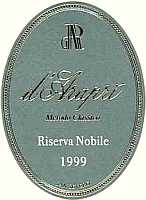
|
|
D'Araprì Riserva Nobile 1999 |
|
| D'Araprì (Italy) | |
| Grapes: Bombino Bianco | |
| Price: € 16,00 | Score: |
| This wine shows a brilliant straw yellow color and nuances of straw yellow, good effervescence and foam, fine and persistent perlage. The nose reveals clean, delicate, pleasing and elegant aromas which start with pear and apple followed by banana, hawthorn, hazelnut and vanilla as well as hints of bread crust, yeast and honey. In the mouth has good correspondence to the nose, a crisp and soft attack with good effervescence and good balance, intense flavors, good body and agreeable. The finish is persistent with flavors of apple and pear. The base wine used for the production of this sparkling wine ferments in barrique and ages in bottle on the lees for at least 48 months. | |
| Food Match: Roasted fish, Pasta and risotto with fish, Crustaceans, Fish soups | |
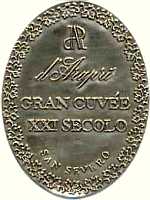
|
|
D'Araprì Gran Cuvée XXI Secolo 1997 |
|
| D'Araprì (Italy) | |
| Grapes: Bombino Bianco, Pinot Noir | |
| Price: € 20,00 | Score: |
| This wine shows a brilliant straw yellow color and nuances of straw yellow, good effervescence and foam, fine and persistent perlage. The nose reveals intense, clean, pleasing and elegant aromas which start with aromas of yeast and toasted bread followed by aromas of pineapple, hawthorn, green apple, hazelnut, pear and grapefruit as well as hints of honey. In the mouth has good correspondence to the nose, a crisp and effervescent attack however balanced, good body, intense flavors and agreeable. The finish is persistent with flavors of green apple and pear. This sparkling wine is produced in the best vintages only and ages on lees for at least 60 months. | |
| Food Match: Roasted fish, Pasta and risotto with fish and mushrooms, Crustaceans, Fish soups | |
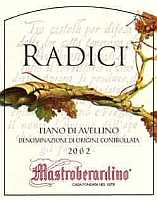
|
|
Radici Fiano di Avellino 2002 |
|
| Mastroberardino (Italy) | |
| Grapes: Fiano | |
| Price: € 8,60 | Score: |
| The wine shows a brilliant greenish yellow color and nuances of greenish yellow, very transparent. The nose reveals intense, pleasing and clean aromas which start with fruits such as apple, pear, pineapple and grapefruit followed by good aromas of broom, hawthorn and almond. In the mouth has good correspondence to the nose, a slightly pleasing crisp attack however balanced, intense flavors and good body. The finish is persistent with flavors of pear, apple and pineapple. This wine ferments in cask and is aged in bottle for 3-4 months. | |
| Food Match: Aperitifs, Eggs, Pasta and risotto with vegetables, Sauteed fish | |
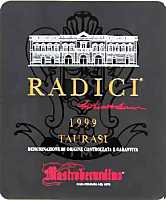
|
|
Radici Taurasi 1999 |
|
| Mastroberardino (Italy) | |
| Grapes: Aglianico | |
| Price: € 16,00 | Score: |
| The wine shows a beautiful and brilliant ruby red color and nuances of garnet red, moderate transparency. The nose reveals clean, elegant and pleasing aromas which start with a pleasing aroma of black pepper followed by good and intense aromas of black cherry jam, strawberry jam, plum jam and carob as well as pleasing hints of licorice, blueberry and vanilla. In the mouth has good correspondence to the nose, a slightly tannic attack however well balanced by alcohol, good body and intense flavors. The finish is persistent with pleasing flavors of plum, black cherry, blueberry and black pepper. A well made wine. Radici Taurasi ages for 24 months in cask followed by at least 12 months of aging in bottle. | |
| Food Match: Roasted meat, Braised meat with mushrooms, Game, Hard cheese | |
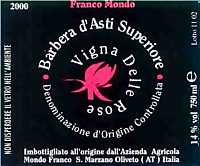
|
|
Barbera d'Asti Superiore Vigna delle Rose 2000 |
|
| Franco Mondo (Italy) | |
| Grapes: Barbera | |
| Price: € 10,00 | Score: |
| This Barbera shows an intense ruby red color and nuances of garnet red, little transparency. The nose reveals good personality with intense, clean, pleasing and elegant aromas of black cherry, blueberry, plum and violet followed by good aromas of vanilla, licorice, dried rose as well as a hint of menthol. In the mouth has good correspondence to the nose, a slightly tannic attack however well balanced by alcohol, full body and intense flavors. The finish is persistent with good flavors of plum, black cherry and blueberry. A well made wine. This Barbera ages in barrique for some months followed by a short aging in bottle. | |
| Food Match: Braised and stewed meat, Roasted meat, Game, Hard cheese | |
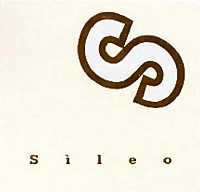
|
|
Piemonte Moscato Passito Sìleo 2000 |
|
| Franco Mondo (Italy) | |
| Grapes: Moscato Bianco | |
| Price: € 16,00 | Score: |
| The wine shows a brilliant amber yellow color and nuances of amber yellow, very transparent. The nose reveals intense, clean, pleasing, elegant and refined aromas which start with the characteristic aromatic hint of Muscat grape followed by aromas of fruit and jams such as raisin, dried apricot, candied fruit, fig jam, quince jam, peach jam, orange marmalade, litchi and citrus fruit peel as well as pleasing and clean aromas of vanilla, toffee and lavender. In the mouth has good correspondence to the nose, a round and velvety attack however well balanced, very pleasing sweetness, good body and intense flavors. The finish is persistent with good flavors of raisin, candied fruit, orange marmalade and dried apricot. A well made wine. Sileo ferments in barrique for some months. | |
| Food Match: Hard and piquant cheese, Fruit tarts, Confectionery | |
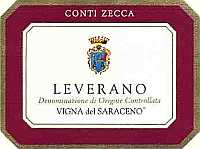
|
|
Leverano Rosso Vigna del Saraceno 2001 |
|
| Conti Zecca (Italy) | |
| Grapes: Negroamaro (70%), Malvasia Nera (20%) | |
| Price: € 4,45 | Score: |
| The wine shows a brilliant ruby red color and nuances of ruby red, moderate transparency. The nose denotes intense, clean, pleasing and elegant aromas of black cherry, blueberry, raspberry, blackberry, plum and violet. In the mouth has good correspondence to the nose, a slightly tannic attack however balanced by alcohol, good body and intense flavors. The finish is persistent with pleasing flavors of black cherry, plum and blueberry. This wine ages for about three years. | |
| Food Match: Stuffed pasta with meat, Broiled meat and barbecue, Hard cheese | |
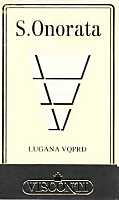
|
|
Lugana S. Onorata 2002 |
|
| Visconti (Italy) | |
| Grapes: Trebbiano di Lugana | |
| Price: € 6,60 | Score: |
| This wine shows an intense greenish yellow color and nuances of greenish yellow, very transparent. The nose reveals intense, clean, pleasing and elegant aromas which start with apple, pear, peach and plum followed by pleasing aromas of broom, chamomile and hawthorn as well as a pleasing hint of anise- In the mouth has good correspondence to the nose, a round attack however well balanced by acidity, intense flavors and good body. The finish is persistent with good flavors of chamomile, plum and apple. | |
| Food Match: Roasted fish, Sauteed meat, Roasted white meat, Pasta and risotto with fish | |
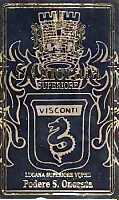
|
|
Lugana S. Onorata Superiore 2001 |
|
| Visconti (Italy) | |
| Grapes: Trebbiano di Lugana | |
| Price: € 9,00 | Score: |
| This wine shows a soft straw yellow color and nuances of greenish yellow, very transparent. The nose reveals intense, clean, pleasing and elegant aromas of apple, pear, peach and plum followed by pleasing aromas of hawthorn and wistaria. In the mouth has good correspondence to the nose, a balanced attack, very agreeable, intense flavors and good body. The finish is persistent with flavors of plum and pear. This wine ages for a short period of time in barrique. | |
| Food Match: Mushrooms soup, Pasta and risotto with mushrooms, Soft cheese, Sauteed meat | |
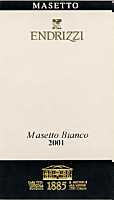
|
|
Masetto Bianco 2001 |
|
| Endrizzi (Italy) | |
| Grapes: Chardonnay, Pinot Gris, Sauvignon Blanc, Traminer | |
| Price: € 10,00 | Score: |
| This wine shows a brilliant greenish yellow color and nuances of greenish yellow, very transparent. The nose denotes intense, clean, pleasing and refined aromas that start with pear, apple, litchi, melon, peach and plum followed by a pleasing hint of broom. In the mouth has good correspondence to the nose and a slightly round attack however pleasing and well balanced by acidity, intense flavors and good body. The finish is persistent with good flavors of peach, plum and pear. Masetto Bianco partly ferments in steel tanks and partly in barrique. | |
| Food Match: Soft cheese, Sauteed fish, Sauteed white meat, Pasta and risotto with vegetables | |
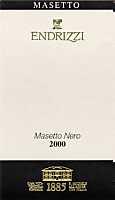
|
|
Masetto Nero 2000 |
|
| Endrizzi (Italy) | |
| Grapes: Merlot, Cabernet Sauvignon, Lagrein, Teroldego | |
| Price: € 11,50 | Score: |
| The wine shows an intense ruby red color and nuances of ruby red, little transparency. The nose reveals intense, clean and pleasing aromas which start with black cherry, blueberry, plum and carob followed by good aromas of violet and vanilla as well as hints of thyme and licorice. In the mouth has good correspondence to the nose, very balanced and agreeable, pleasing tannins, good body and intense flavors. The finish is persistent with pleasing flavors of black cherry, blueberry and plum. A well made wine. Masetto Nero ages in barrique for 18 months followed by 6 months of aging in bottle. | |
| Food Match: Roasted meat, Braised meat with mushrooms, Hard cheese | |
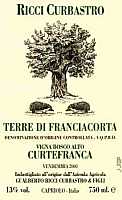
|
|
Terre di Franciacorta Bianco Vigna Bosco Alto 2000 |
|
| Ricci Curbastro (Italy) | |
| Grapes: Chardonnay | |
| Price: € 10,00 | Score: |
| The wine shows an intense straw yellow color and nuanced of golden yellow, very transparent. The nose reveals good personality with intense, clean, pleasing and refined aromas which start with a hint of toasted followed by good aromas of banana, apple, pear and grapefruit followed by aromas of hawthorn, yeast, vanilla and a pleasing hint of flint. In the mouth has good correspondence to the nose, a slightly crisp attack however well balanced by alcohol, good body and intense flavors. The finish is persistent with pleasing flavors of peach, grapefruit and pear. This wine ferments in barrique and ages on its lees for one year followed by 8-12 months of aging in bottle. | |
| Food Match: White meat, Roasted and broiled fish, Pasta with fish, Soft cheese | |
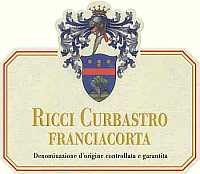
|
|
Franciacorta Extra Brut 1999 |
|
| Ricci Curbastro (Italy) | |
| Grapes: Chardonnay (50%), Pinot Noir (50%) | |
| Price: € 15,00 | Score: |
| The wine shows a brilliant golden yellow and nuances of golden yellow, Good effervescence and foam, fine and persistent perlage. The nose reveals intense, clean, pleasing and elegant aromas which start with pineapple, broom, apple, pear, banana and plum followed by pleasing aromas of yeast, honey, hazelnut and toasted bread. In the mouth has good correspondence to the nose, a dry and effervescent attack however well balanced by good acidity and alcohol, good body and intense flavors. The finish is persistent with good flavors of pear, apple and plum. This Franciacorta is produced in the best vintages only and ages in bottle, at the end of secondary fermentation, for 42 months and no dosage is added (Pas Dosè). | |
| Food Match: Crustaceans, Roasted fish, Pasta and risotto with fish | |

|
|
Colli di Faenza Sangiovese Col Mora 2000 |
|
| Rontana (Italy) | |
| Grapes: Sangiovese | |
| Price: € 10,00 | Score: |
| This wine shows an intense ruby red color and nuances of ruby red, moderate transparency. The nose reveals intense, clean and pleasing aromas of black cherry, raspberry, blueberry and plum followed by pleasing hints of menthol and carob. In the mouth has good correspondence to the nose, a slightly tannic attack however balanced, good body and intense flavors. The finish is persistent with pleasing flavors of plum and blueberry. | |
| Food Match: Stuffed pasta with mushrooms, Sauteed meat, Cold cuts, Hard cheese | |

|
|
Colli di Faenza Rosso Riserva Colle Torre Monte 2000 |
|
| Rontana (Italy) | |
| Grapes: Cabernet Sauvignon (40%), Sangiovese (40%), Merlot (20%) | |
| Price: € 16,00 | Score: |
| The wine shows a deep ruby red color and nuances of ruby red, little transparency. The nose reveals intense, clean, pleasing and elegant aromas which start with black cherry, raspberry, blueberry, plum, black currant and violet followed by good aromas of vanilla and carob as well as a pleasing hint of black pepper. In the mouth has good correspondence to the nose, a slightly alcoholic attack however balanced by tannins, good body and intense flavors. The finish is persistent with pleasing flavors of plum, black cherry and raspberry. A well made wine. Colle Torre Monte ages for 20 months in barrique followed by an aging in bottle of at least 10 months. | |
| Food Match: Game, Roasted meat, Braised and stewed meat, Hard cheese | |
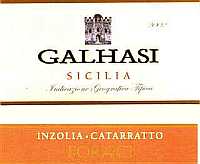
|
|
Galhasi Inzolia - Catarratto 2002 |
|
| Foraci (Italy) | |
| Grapes: Inzolia, Catarratto | |
| Price: € 4,80 | Score: |
| The wine shows a brilliant straw yellow color and nuances of straw yellow, very transparent. The nose reveals intense, clean, pleasing and elegant aromas which start with an aroma of hawthorn followed by good aromas of pear, peach, pineapple, citrus fruits, almond and pleasing hints of elder. In the mouth has good correspondence to the nose, a pleasing and crisp attack however well balanced, good body and intense flavors. The finish is persistent with flavors of peach, pear and almond. This wine ferments in steel tanks. | |
| Food Match: Pasta and risotto with fish, Broiled fish, Crustaceans | |
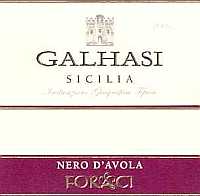
|
|
Galhasi Nero d'Avola 2001 |
|
| Foraci (Italy) | |
| Grapes: Nero d'Avola | |
| Price: € 5,10 | Score: |
| The wine shows an intense ruby red color and nuances of ruby red, little transparency. The nose denotes intense, clean, pleasing and elegant aromas which start with a pleasing hint of black pepper followed by aromas of black cherry, raspberry, blueberry, plum and violet as well as hints of licorice, vanilla and carob. In the mouth has good correspondence to the nose, a slightly tannic attack however balanced by alcohol, good body and intense flavors. The finish is persistent with pleasing flavors of black cherry, plum and blueberry. A well made wine. This Nero d'Avola is aged in cask. | |
| Food Match: Braised and stewed meat with mushrooms, Roasted meat, Hard cheese | |
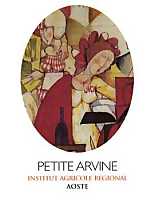
|
|
Vallée d'Aoste Petite Arvine 2002 |
|
| Institut Agricole Régional (Italy) | |
| Grapes: Petite Arvine | |
| Price: € 8,00 | Score: |
| The wine shows a brilliant straw yellow color and nuances of straw yellow, very transparent. The nose reveals intense, clean, pleasing, elegant and refined aromas which start with pleasing aromas of elder and pineapple followed by banana, hawthorn, apple, broom, pear and peach. In the mouth has good correspondence to the nose, a crisp and slightly round attack however well balanced, good body, intense flavors and very agreeable. The finish is persistent with good flavors of pear, pineapple and peach. A well made wine. | |
| Food Match: Pasta and risotto with vegetables, Soft cheese, Sauteed fish | |
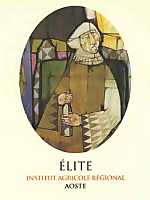
|
|
Élite 2001 |
|
| Institut Agricole Régional (Italy) | |
| Grapes: Viognier | |
| Price: € 10,60 | Score: |
| The wine shows a soft straw yellow color and nuances of greenish yellow, very transparent. The nose reveals good personality with intense, clean, elegant, pleasing and refined aromas which start with an intense aroma of peach followed by pleasing aromas of banana, litchi, apple, pear, grapefruit, hazelnut, acacia, hawthorn as well as pleasing aromas of vanilla and toasted. In the mouth has excellent correspondence to the nose, very balanced, pleasing crispness, good body and intense flavors. The finish is very persistent with flavors of peach, pear, apple and hazelnut. A well made wine. Élite ages in steel tanks for 3 months followed by 9 months in barrique and 1 month of aging in bottle. | |
| Food Match: White meat, Roasted meat, Soft cheese, Pasta and risotto with fish | |
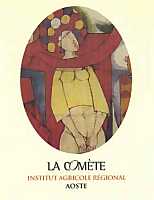
|
|
La Comète 2001 |
|
| Institut Agricole Régional (Italy) | |
| Grapes: Sauvignon Blanc | |
| Price: € 12,60 | Score: |
| The wine shows an intense straw yellow color and nuances of golden yellow, very transparent. The nose has great personality with intense, clean, pleasing, elegant and refined aromas which start with pleasing aromas of banana, acacia and vanilla followed by intense and good aromas of hawthorn, broom, litchi, hazelnut, peach, apple, grapefruit as well as pleasing hints of brioche, butter and toasted. In the mouth has excellent correspondence to the nose, very balanced, pleasing crispness, good body and intense flavors. The finish is very persistent with long flavors of banana, peach, pear, hazelnut and grapefruit. A great wine. La Comète ages in steel tanks for 3 months followed by 9 months in barrique and 1 month of aging in bottle. | |
| Food Match: Pasta and risotto with fish, truffle, White meat, Roasted and broiled fish | |
Enzo BogliettiDetermination, passion and firm ideas as well as a great and generous land capable of producing extraordinary grapes: these are the elements from which Enzo Boglietti's wines take their origin |
|
Talking about Langhe makes certainly think about Piedmont's great wines, a historical bond that characterized the region since ever. However the most frequent thought associated to Langhe is about a particular wine, a great wine, one of those wines which made the fame of Italian wines famous all over the world: Barolo. This extraordinary wine, produced with Nebbiolo grape, has a pretty recent history and its deserved notoriety was thanks to the intuition of a great wine maker, French Louis Oudart, who revolutionized the production of this wine and made it one of the greatest of the world, a position Barolo still keep nowadays. The history of Barolo, defined as “wine of kings, kings of wine”, began around the half of 1800's when Marquise of Barolo, Giulietta Falletti, asked wine maker Louis Oudart, called in the Langhe by Camillo Benso count of Cavour, to improve the wines produced in her winery. Louis Oudart realized the productive faults of those wines were in the fermentation process, which was not done completely, and transformed Barolo from a sweet wine to a great dry wine. His results convinced Cavour to call Oudart to his castle in Grinzane in order to make the “new wine” and even king Vittorio Emanuele II converted his estate near the residence of Fontanafredda, in Serralunga d'Alba, to the production of this wine.
The generous land of Langhe has a long and important tradition for great wines as well as great producers. Among the many places of Langa renowned for the production of wine there is the city of La Morra, with its 640 hectares of specialized vineyards (1,580 acres), of which about 400 (988 acres) cultivated with Nebbiolo grapes for the production of Barolo, is now a city renowned all over the world. Historical documents have proved the importance of La Morra as a land suited for the production of wine. It is believed that since Roman times vineyards were cultivated on the western side of the La Morra's hill towards Cherasco, on the land coasting Tanaro river. This hypothesis is also supported by many archaeological evidences dated back to Roman times and found in the valley of Rivalta, in the fields near the ancient walls of Pollenzo. However it will pass about one thousand years before the grapes of this land will be capable of producing the current and great wines of La Morra. In La Morra, one of the great homelands of Barolo, there is Enzo Boglietti's winery, ingenious and extroverted wine producer, with passion and strong convictions on how to make wine, in the short time of about ten years, he was successful in producing truly high quality wines which are renowned and looked for in many countries of the world. The production of wine in Enzo Boglietti's winery is pretty recent, it started in 1991 when he decided to make wine with his own grapes instead of selling them. In that year the total production was of about 10.000 bottles of which 2.600 of Barolo Vigna delle Brunate, 2.800 of Dolcetto, 3.200 of Langhe Nebbiolo and 1.200 of Barbera d'Alba Vigna dei Romani. Since then the success of Enzo Boglietti's wines has been striking and surprised wine lovers for their excellent characteristics. In 1993 starts the production of three new wines: Barolo Case Nere, Langhe Buio and Barbera d'Alba. In 1996 Gianni Boglietti, brother of Enzo, starts is stable collaboration with the winery and in that year were produced for the first time Barolo Fossati and Dolcetto d'Alba Tiglineri. In the same year wine maker Sergio Molino starts his stable collaboration with the winery.
Since the beginnings of the business the productive strategy has been oriented towards the valuation of the typical characteristics of the vine and of the single vineyards, as well as keeping a high and strict level of quality. Casks used for the aging of wines are always brand new and are used for the production of the main wines of the winery and are subsequently used, in the course of years and after subsequent usage, for the production of other wines. Enzo Boglietti's wines are produced with the grapes cultivated in winery's estates, with cultivations of very low environmental impact. The production does not make use of biotechnologies and for the stabilization is uniquely used potassium metabisulphite and fresh eggs albumen for clarifying wines. In the course of years new vineyards have been acquired, as well as renting others, among them also a 40 years old vineyard, acquired in 1999, located in La Morra, where the grapes for the production of Barbera Roscaleto are harvested. The winery currently has 8 hectares of vineyards (20 acres) and 10.5 hectares rented (26 acres). The production is increased and in 2003 have been produced about 70.000 bottles. Enzo Bogglietti's wines, once they are tasted, leave a mark and they are unforgettable for their interpretation and quality. Not only Barolo wines are impressive, but also the other wines, such as the superb Barbera d'Alba Vigna dei Romani or the excellent Dolcetto d'Alba Tiglineri. Excellent are also the wines considered as base products of the winery, such as Langhe Nebbiolo and Barbera d'Alba; correct and well made wines. These two “base” wines, despite the fact they are considered as products of lesser prestige, both aged in cask, convince for their excellent production, clean aromas and good structure. Extremely interesting is also Langhe Buio, produced with Nebbiolo and Barbera grapes, very convincing and well made, where the characteristics of the grapes used for their production are clearly recognizable. Also excellent the interpretation of Dolcetto d'Alba Tiglineri: this wine, aged in cask, has a firm structure where typical aromas of the grapes are clearly perceivable as well as a pleasing spicy hint. Excellent are also the two Barbera “Roscaleto” and “Vigna dei Romani”. Barbera d'Alba Roscaleto is appreciable for its refined aromas and its balance, certainly a good wine. Barbera d'Alba Vigna dei Romani, one of the historical products of the winery, impresses for its strength, the excellent quality as well as for its elegance and finesse of aromas: a great Barbera. Enzo Boglietti's wines also include three great Barolo, very elegant, refined and of high quality: Barolo Case Nere, Barolo Fossati and Barolo Brunate. All the three wines are aged in barrique, 24 months for Case Nere and Fossati, 15 months for Brunate which continues its aging in cask for 15 months more. These wines have extraordinary characteristics, impressive structures and very clean, elegant and refined aromas: certainly three unforgettable wines that leave a mark for their charm. In the list of wines reviewed in this report are not included Dolcetto d'Alba Tiglineri, Barbera d'Alba Vigna dei Romani and Barolo Brunate because they have been reviewed on DiWineTaste few months ago and they are all available in the wines guide. Enzo Boglietti's winery is available for the tasting of his wines and reservations can be ordered by phoning the winery or by sending an E-Mail.
|
||||||||||||||||||||
|
Score legend Prices are to be considered as indicative. Prices may vary according to the country or the shop where wines are bought |
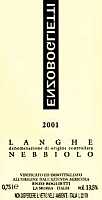
|
|
Langhe Nebbiolo 2001 |
|
| Enzo Boglietti (Italy) | |
| Grapes: Nebbiolo | |
| Price: € 10,50 | Score: |
| This Nebbiolo shows a brilliant ruby red color and nuances of ruby red, moderate transparency. The nose reveals intense, clean and pleasing aromas of black berry, blueberry, plum and violet followed by a pleasing hint of vanilla. In the mouth has good correspondence to the nose, a slightly tannic attack however balanced by alcohol, good body and intense flavors. The finish is persistent with pleasing flavors of black cherry and blueberry. This wine ages for 10 months in cask. | |
| Food Match: Braised and stewed meat, Roasted meat, Hard cheese | |
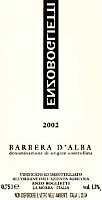
|
|
Barbera d'Alba 2002 |
|
| Enzo Boglietti (Italy) | |
| Grapes: Barbera | |
| Price: € 8,50 | Score: |
| The wine shows an intense ruby red color and nuances of ruby red, moderate transparency. The nose reveals intense, pleasing, clean and elegant aromas of fruits such as black cherry, blueberry and plum followed by good aromas of violet, licorice and vanilla. In the mouth has good correspondence to the nose, very balanced, a pleasing roundness and very agreeable, good tannins, good body and intense flavors. The finish is persistent with good flavors of black cherry, plum and blueberry. This Barbera ages for 8 months in casks and in steel tanks. | |
| Food Match: Sauteed meat with mushrooms, Roasted meat, Stewed meat | |
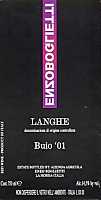
|
|
Langhe Rosso Buio 2001 |
|
| Enzo Boglietti (Italy) | |
| Grapes: Nebbiolo (80%), Barbera (20%) | |
| Price: € 21,00 | Score: |
| The wine shows a brilliant ruby red color and nuances of garnet red, moderate transparency. The nose reveals intense, clean, pleasing, elegant and refined aromas with good personality that start with an aroma of lemon verbena followed by good aromas of black cherry, strawberry jam, raspberry, plum and violet as well as hints of licorice and vanilla. In the mouth has good correspondence to the nose, an alcoholic attack which slightly tend to prevail, however balanced by good tannins, good body and intense flavors. The finish is persistent with good flavors of plum, raspberry and black cherry. Buio ages for 16 months in barrique and for 4 months in bottle. | |
| Food Match: Roasted meat, Braised and stewed meat, Hard cheese | |
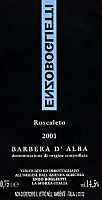
|
|
Barbera d'Alba Roscaleto 2001 |
|
| Enzo Boglietti (Italy) | |
| Grapes: Barbera | |
| Price: € 17,00 | Score: |
| This Barbera shows a beautiful and brilliant ruby red color and nuances of ruby red, moderate transparency. The nose denotes intense, clean, pleasing and elegant aromas that start with pleasing aromas of black cherry, raspberry, blueberry, plum and violet followed by good aromas of licorice and vanilla as well as hints of hazelnut and peach jam. In the mouth has good correspondence to the nose, a slightly alcoholic and crisp attack however well balanced by tannins, good body and intense flavors. The finish is persistent with pleasing flavors of plum, black cherry and blueberry. A well made wine. This Barbera ages for 16 months in barrique followed by 4 months in bottle. | |
| Food Match: Game, Roasted meat, Stewed and braised meat, Hard cheese | |
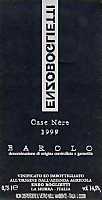
|
|
Barolo Case Nere 1999 |
|
| Enzo Boglietti (Italy) | |
| Grapes: Nebbiolo | |
| Price: € 41,00 | Score: |
| This Barolo shows a brilliant ruby red color and nuances of garnet red, moderate transparency. The nose reveals good personality with intense, clean, pleasing, elegant and refined aromas which start with violet followed by intense aromas of black cherry jam, raspberry jam, plum jam as well as aromas of toffee, licorice, dried rose, enamel and vanilla. In the mouth has good correspondence to the nose, a slightly alcoholic attack which tend to prevail, however well balanced by good tannins, good body and intense flavors. The finish is persistent with pleasing flavors of plum jam, black cherry jam and raspberry jam. A well made wine. This Barolo ages for 24 months in barrique followed by 14 months in bottle. | |
| Food Match: Braised and stewed meat, Game, Roasted meat, Hard cheese | |
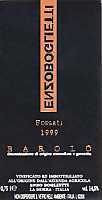
|
|
Barolo Fossati 1999 |
|
| Enzo Boglietti (Italy) | |
| Grapes: Nebbiolo | |
| Price: € 41,00 | Score: |
| This Barolo shows a brilliant ruby red color and nuances of garnet red, moderate transparency. The nose reveals good personality and clean, intense, elegant, refined and pleasing aromas which start with pleasing aromas of black cherry jam, plum jam and vanilla followed by good aromas of raspberry, blueberry, violet and dried rose as well as hints of toffee, tar, leather and licorice. In the mouth has good correspondence to the nose, a firm and slightly alcoholic attack however well balanced by good tannins, full body and intense flavors. The finish is very persistent with long and clean flavors of plum jam, black cherry jam and raspberry. A well made Barolo. This wine ages for 24 months in barrique followed by 14 months of aging in bottle. | |
| Food Match: Game, Braised and stewed meat, Roasted meat, Hard cheese | |
| Azienda Agricola Enzo Boglietti - Via Roma, 37 - 12064 La Morra, Cuneo - Italy Tel. e Fax +39 0173 50330 - Winemaker: Sergio Molino - Established: 1991 - Production: 70.000 bottles - E-Mail: enzoboglietti@virgilio.it |
Cellar Journal |
|
This section is reserved to wine producers who want to publish news and information about their business, to announce new products or just for communicating to their customers information and promotions about their products and activity. Send news to be published at our e-mail address.
|
News |
|
In this section will be published news and information about events concerning the world of wine and food. Whoever is interested in publishing this kind of information can send us a mail at our address.
|
Matching Food with Sweet and Botrytised WinesEnchanting aromas and intense flavors: the elegance and finesse of sweet and botrytised wines surprises with food as well, not just with cakes and confectionery |
|
Sweet and botrytised wines have always been highly praised in the course of history, rare and precious wines that were capable of obtaining the highest appreciation in every country and the preference of connoisseurs that could afford buying this grape nectars. The fame of sweet and botrytised wines, in the course of centuries, did not change, even today they are considered among the best examples of excellence in the wine scene and it is rare to find someone who does not like them. Indisputable protagonists among the so called “meditation wines”, to be slowly sipped and placidly contemplated, sweet and botrytised wines are also capable of making interesting matchings with food, most of the times surprising and amazing. The elegance and finesse of these wines is frequently used in cooking for the preparation of some recipes, in particular for pastry cooking, where their “magic touch” is always noticed and appreciated. Among the most common matching, as well as foregone, where sweet and botrytised wines are being used, there are cakes and confectionery, a sure and adequate matching, sweet wines and sweet foods are excellent companions. Moreover these wines can be happily matched to salty and very tasty foods, such as cheese, in particular hard and piquant cheese.
|
|
Sweet and botrytised wines were very looked for in the past and they were very appreciated and common in ancient times, in particular they were very appreciated by Greeks and ancient Romans. The fame and appreciation for these wines have not changed, despite the wine making technique has evolved in the course of time, and with that the taste of people as well, while producing dry wines that in past times would have not probably been appreciated, the preference for sweet wines, as well as for their charm and elegance, is still very appreciated by wine lovers. The production of sweet and botrytised wines is made in almost every wine producing country, however some of them have a longer and more ancient tradition, and in many cases, some areas or regions are famous thanks to the production of sweet wines and their name is indissolubly tied to these wines. Greece, ancient producer of sweet wines to which goes the merit for having contributed to the spreading and appreciation of these wines in ancient times, still produces interesting sweet wines with Muscat Blanc grape. Among the most renowned examples of the Hellenic territory there are Muscat of Samos, produced in the homonymous island, and Muscat of Patras, both produced with Muscat Blanc grape. Another ancient wine which was very renowned in the past centuries was Commandaria, produced in the Cyprus island, a sweet wine that can also be fortified, now considered as a rarity and produced with Mavro and Xynisteri grapes. Among the glorious sweet wines of the past there also is Constantia, produced in South Africa, and recently is reviving its magnificent fame of the past. This wine, which was very appreciated by Napoleon Bonaparte, is produced with Muscat of Alexandria and Pontac grapes.
In Europe sweet and botrytised wines have always had a primary role in the wine scene and almost every country of the old continent has ancient and traditional productions. France, among the renowned European countries for the production of sweet wines, offers a vast and rich selection of dessert wines, in particular produced with Muscat Blanc à Petits Grains grape. Among the most renowned French areas there is Languedoc-Roussillon where the production of vin doux naturel is the richest of France. Vin doux naturel are sweet wines that should belong to the family of fortified wines, as some alcohol is added during the process of fermentation in order to stop the action of yeasts and to keep grape sugar, a technique known in enology as mutage. Among the most famed sweet wines of Languedoc-Roussillon there are the ones produced with Muscat Blanc à Petits Grains grape and produced in the areas which also give the name to the wine: Muscat de Rivesaltes, Muscat de Lunel, Muscat de Frontignan, Muscat de Mireval and Muscat de Saint-Jean-de-Minervois. In Languedoc-Roussillon are also produced other renowned vin doux naturel: Banyuls and Maury, both produced with Grenache Noir grape, and Rivesaltes usually produced with Grenache Noir, Maccabeu, Malvoisie and Muscat Blanc grapes. The most renowned sweet wines of France are probably the ones produced in two small areas of the Bordeaux region: Sauternes and Barsac. These two splendid wines, that belong to the category of botrytised wines, are generally produced with Sémillon grape, to which may be added Sauvignon Blanc and Muscadelle as well, and all grapes must be affected by noble rot Botrytis Cinerea. Not far and north from Sauternes and Barsac, there is Cadillac, another renowned area for the production of sweet wines in Bordeaux, whose grapes are partially affected by noble rot. East from Bordeaux there is an interesting area for the production of botrytised wines, Bergerac, not very popular, probably because the notoriety of Sauternes and Barsac, in particular for its wines produced in Monbazillac with Sémillon, Sauvignon Blanc and Muscadelle grapes. In the same region are also produced sweet wines belonging to the appellation of Côtes de Bergerax Moelleux. Among French vin doux naturel are also included the renowned Muscat de Beaumes-de-Venise, produced with Muscat Blanc à Petits Grains and Rasteau grapes, and Rasteau, with Grenache grapes, both produced in the Rhône. Even the Loire Valley, famous for its white wines, produces sweet wines with Chenin Blanc grapes, of which the most representative ones are Coteaux du Layon, Bonnezeaux and Quarts-de-Chaume. Among other sweet wines of France should be mentioned the famous Vin de Paille produced in Jura, usually made with Savagnin, Poulsard and Chardonnay grapes dried on mats or hanged, as well as Muscat du Cap Corse, produced in Corsica island, with Muscat Blanc à Petits Grains grape. The production of sweet wines in Italy is pretty vast and virtually every region, from north to south, produces its typical sweet wines, fundamental part of their traditions and history. In Vallée d'Aoste are produced the excellent sweet wines Moscato Passito di Chambave or Muscat Flétri, with Muscat Blanc grape, and Nus Malvoisie Passito or Malvoisie Flétri, with Pinot Gris grape. Muscat Blanc grape is also used in Piedmont for the production of sweet wines, such as Moscato Passito, produced in all the region, as well as the excellent Loazzolo. In the region are also produced the splendid Erbaluce Passito di Caluso, with Erbaluce grape, and Malvasia di Casorzo Passito. In Lombardy is produced the Moscato di Scanzo, a sweet wine unfortunately very rare even though it is getting more and more popular. The neighboring Veneto offers a good selection of sweet wines, such as the renowned Recioto della Valpolicella, with Corvina, Rondinella and Molinara grapes, and Recioto di Soave, mainly produced with Garganega grape. In this region are also produced Torcolato, with Vespaiola, Tocai, Garganega, Pedevenda and Durella grapes, as well as Colli Euganei Fior d'Arancio, produced with Muscat Blanc grape. In Trentino is produced an excellent Vin Santo with Nosiola grape, in particular near the lake of Toblino. In Friuli Venezia Giulia, three are the sweet wines to be famed: Ramandolo and Verduzzo, both produced with Verduzzo Friulano grape, and the rare and precious Picolit, produced with homonymous grape. In Liguria, in the area of Cinque Terre, with Bosco, Vermentino and Albarola grapes is produced the excellent Sciacchetrà. In Emilia Romagna the production of sweet wines is mainly made with the most renowned white berried grape of the region, Albana, used to make passito wines. The regions of Tuscany, Umbria and Marche are all characterized by the traditional production of Vin Santo, generally produced with typical white berried grapes of the regions, with the exception of Tuscany which also make use of red berried grapes, in particular Sangiovese, and is called Occhio di Pernice. In Tuscany are also famous two sweet wines: Aleatico dell'Elba, produced with Aleatico grape, and Moscadello di Montalcino, produced with Muscat Blanc grape. In Umbria is renowned Sagrantino di Montefalco Passito, produced with Sagrantino grapes, whereas in Marche are produced sweet wines with dried Verdicchio grape. Umbria is also renowned for botrytised wines from Orvieto, among the few areas of Italy where Botrytis Cinerea can be found. Latium produces Aleatico di Gradoli, with the homonymous red berried grape. In southern regions of Italy the production of sweet wine is very typical, in particular in Campania with Falanghina grape, Apulia with Primitivo and Molise with Muscat Blanc, although they all are not recognized by any DOC disciplinary, they all are wines worth of attention. In Calabria is produced the excellent Greco di Bianco, a sweet wine now rare and produced with Greco grape. Sicily offers a rich selection of sweet wines, such as the excellent Malvasia delle Lipari, produced with the homonymous grape and Corinto nero, as well as the renowned Moscato di Pantelleria, produced with Muscat of Alexandria grape, locally called Zibibbo. Among other sweet wines of the region are to be mentioned Moscato di Noto and Moscato di Siracusa, both produced with Muscat Blanc grape. The production of sweet wines is also interesting in Sardinia, in particular for Malvasia di Bosa and Malvasia di Cagliari, both produced with Malvasia di Sardegna grape, and Moscato di Sorso-Sennori, with Muscat Blanc grape. Among the greatest sweet wines producing countries are also included Germany, in particular for Beerenauslese, Trockenbeerenauslese and Eiswein wines, produced with white berried grapes and in particular with Riesling, Ehrenfelser and Scheurebe. Even Austria is renowned for its excellent sweet wines, in particular in the area of Burgenland with Beerenauslese, Trockenbeerenauslese and Eiswein wines as well as the renowned Ausbruch. Austrian sweet wines are generally produced with Welschriesling, Weissburgunder, Neuberger, Traminer and Furmint grapes. Hungary, among the very first producers of sweet wines in Europe, is renowned for its excellent Tokaji Aszú, produced near Tokay with Furmint grapes affected by noble rot Botrytis Cinerea. Even to the other side of the Atlantic ocean, in the American continent, are produced interesting sweet wines, in particular in Canada and in the state of New York. In these two areas are produced the so called ice wines by using the same techniques for the production of German and Austrian Eiswein. Grapes used for the production of ice wines in the state of New York are Vidal Blanc, a French-American hybrid produced by crossing Ugni Blanc and Seibel 4986, and Vignoles. Canadian ice wines are usually produced with Vidal Blanc and Riesling grapes.
|
||||||||||||
|
Sweet and botrytised wines are generally matched to foods according to the “concordance” rule, that is they are matched to those foods which basically have the same organoleptic characteristics of wine, in particular sweetness and roundness. According to this premise it could be thought that sweet and botrytised wines are solely matchable to cakes and sweet foods, that is to those foods evidently having the analogous organoleptic characteristics, however these wines allow the matching with other foods which are not sweet at all, such as cheese and, sometimes, to some recipes based on meat. Before discussing the matching of sweet and botrytised wines with food, it is necessary to give some advices about the way they should be served. First of all glass. By considering the value and, last but not the least, the alcohol by volume of these wines, usually higher when compared to dry wines, the quantity to be served will not be high; thanks to the intensity of flavors and to the persistence of these wines, a little sip will be enough to appreciate their extraordinary organoleptic qualities. Therefore, the glass to be used will be small, with a large body and narrow opening in order to concentrate aromas. Another important aspect for the service of these wines is about temperature. Sweet and botrytised wines are the only ones to be generally served at a pretty wide range, usually from 10° and 18° C (50°-65° F), and this factor is mainly influenced by personal preference. It should be remembered the relative perception of sweetness is higher at high temperatures and, on the other hand, it attenuates at low temperatures, therefore a sweet wine served at a high temperature could also taste sickly. The same principle also applies to alcohol, whereas for astringency the opposite principle is valid. Sweet wines produced with white berried grapes can be served at lower temperatures, whereas the ones produced with red berried grapes are usually served at higher temperatures in order to mitigate the effects of astringency. Moreover, temperature influences the development of aromas which tends to accentuate at higher temperatures; a sweet wine served too cool could penalize the perception of its aromas. The choice of serving temperature for a sweet wine when it is going to be matched, also depends by the food served: in case of a wine matched to a warm food, such as a crêpe filled with jam, it is good to serve it at a temperature of two or three degrees higher in order not to have a too much pronounced thermal contrasts. The main organoleptic qualities of sweet and botrytised wines can be summarized as intensity and richness of aromas, higher alcohol by volume, sweetness, roundness, a long taste-olfactory persistence and, in case of wines produced with white berried grapes, appreciable acidity, whereas in wines produced with red berried grapes, appreciable astringency. Most of these characteristics will be matched according to the concordance principle, therefore sweet wines will be matched to foods having a strong aromaticity, such as recipes where are present spices and very aromatic ingredients, which have an appreciable sweetness and a very long taste-olfactory persistence. Generally speaking, these characteristics are common in most of sweets and desserts, in particular the ones made of compact and non leavened dough, rich of aromatic ingredients, such as jam tarts, strüdel, panforte and panpepato. The other characteristics of sweet wines, alcohol, roundness, acidity and astringency, as well as being useful for the matching with sweet foods, allow the matching with salty and rich foods, such as cheese, in particular piquant and hard cheese. In these cases the effect of sweetness is added to roundness therefore increasing the effect of contrasts for aromaticity and sapidity of foods, whereas alcohol, that will contribute to increase roundness as well, will mitigate the succulence of complex foods such as cheese. Even acidity in white sweet wines is useful in contrasting the fattiness of certain cheeses. One of the most preferred matchings for Sauternes is with Roquefort, and the same can be said for a magnificent Passito di Pantelleria matched to Gorgonzola cheese. Sweet wines produced with red berried grapes can be matched with cheese as well: thanks to their astringency, succulence will be mitigated. It is not by chance that in Montefalco, the enchanting city of Umbria where it is produced the renowned Sagrantino di Montefalco Passito, one of the most typical matchings for this wine is with hard cheese, moreover, thanks to its characteristics, it is traditionally matched with roasted lamb during the Easter period. The matching of sweet and botrytised wines with meat, although it can be considered as an exception, is pretty common in France as well: Sauternes and Barsac are traditionally matched to foie gras, fat goose liver. Among the most common matchings with sweet and botrytised wines there are, like we said already, pastry recipes, in particular cakes prepared with complex ingredients, such as jam, dried fruit, candied fruit, spices and compact and non leavened dough, including cookies and biscuits. When the matching is done with a sweet food, the wine to be served will have the same strength and intensity of organoleptic qualities in order to harmonically satisfy the principle of concordance, where food and wine exalt and complete one each other without prevailing on the other.
|
GinProduced by the distillation of cereals and aromatized with juniper berries and other essences, it is one of the most used spirits for the creation of cocktails |
|
|
|
The history of great spirits is always rich of episodes and it is pretty difficult to tell history from legend. Gin is no exception. The history of gin originated in Netherlands. The story goes that a Dutch pharmacist, Sylvius Franciscus, physician and teacher at the University of Leiden, experimented in the seventeenth century a remedy for stomach and kidneys diseases by using alcohol of grain and juniper berries (juniperus communis). That is how the recipe of Jenever was invented, and later it will become “gin”. In Great Britain it is said that in the seventeenth century they produced “Geneva”, by using barley and other cereals blended with juniper berries. As already said, Jenever was intended as a therapeutic remedy that, by using the characteristics of alcohol as well as of juniper berries, could be used as a digestive beverage as well as a remedy for kidneys. This remedy was very successful in Netherlands and later it also arrived in England. In the beginning English imported huge quantity of gin, however they did not just drink it, indeed they also contributed to the evolution and to the development of the beverage that, in the meantime, lost its characteristics of remedy and was mainly used as an alcoholic beverage. In the beginning for the production of gin was used essential oil of juniper berries infused in alcohol. They were English that subsequently infused juniper berries directly with alcohol, as well as coriander berries, orange peel and other vegetal in order to smooth its aroma and its taste. This is how English gin was born, different from its Dutch progenitor: “London dry gin”. Gin rapidly became a very popular liquor, however the continuous increase of consumptions was suddenly stopped by the time it was promulgated a law, the so called “Gin Act”, which limited the selling of gin and imposed a high tax on the beverage, with the result of lowering the spreading in favor of cheaper beverages such as tea. This law, whose purpose was to lower the production and consumption of Geneva, did not obtain the results they hoped, and just like in the United States of America during prohibitionism, in the beginning both production and consumption in England decreased, but this was just a temporary effect. Indeed, the law favored clandestine production and gave a strong impulse to the imports from France and Netherlands, in particular from the city of Schidam, name still used today by English to refer to Dutch gin. The “Gin Act” was abrogated in 1742 with the purpose of limiting smuggling and clandestinity, however the result was an increase in consumption. The law called “Gin Act” did not obtain the results they hoped, however it was not useless, in fact it was thanks to this law, especially after it was abrogated and gin was controlled by the revenue bureau, started a competition among producers with the result of increasing the quality level of the product. Slowly the evolution of distillation techniques improved the product up to nowadays. Currently there are two different techniques used for the production of gin. In Netherlands is used the method of distillation of cereal alcohol (barley, corn, rye and others) blended to juniper berries and other aromatic plants. Sometimes the obtained product is redistilled in order to produce “double gin”. In Great Britain the base product can be any neutral ethyl alcohol which is subsequently aromatized with juniper berries, coriander (coriandrum sativum) and other aromatic herbs as well as anise and fennel seeds, lemon and orange peel, licorice roots, angelica, iris, cardamom, cumin and almonds. This aromatized liquor is subsequently distilled: the final product will be “London dry gin”. Gin is rarely aged, however for its aging are used oak casks which give the beverage a slightly golden color and it named as “golden gin”. Moreover, there is another method used for the production of gin by adding aromatic and essential oils produced by industrial processes to neutral alcohol: a disputable technique which produces a disputable gin. Despite the events happened in the course of its history, gin is still largely consumed in north Europe and north America, drunk both as an aperitif and plain as corroborant, as well as a main ingredient in many cocktails and long drinks.
|
||||
|
The base of gin is a distilled liquor from cereals, such as corn, and juniper berries, coriander seeds and other aromatic herbs, it basically is a colorless product with about 43-45% of alcohol by volume. The most common and popular gins are the ones from England with a characteristic dry taste. Dutch gins, produced with the “pot still”, are richer, more aromatic and structured than the ones from England. As opposed to other styles, Dutch gins are aged from one to three years in oak casks and have a pale golden color. In Italy it is produced a gin by using the best juniper berries from the Mediterranean and producers claim its characteristics are similar to the beverage produced by monks of Alverna, near Arezzo, in the thirteenth century.
There are many types of gin. The “classic” London dry gin, colorless, dry, aromatic, can also be produced as “premium” with a higher alcohol by volume. “Old Tom gin”, colorless and produced in England, sweetened with a little of sugar or sugar syrup, was very popular in England during the eighteenth century. It seems its name derives from the first automatic beverage dispensing machine installed in some English pubs in the 1700's. It seems that after having inserted a penny in the mouth of the cat, a gin shot was served by a bartender through a pipe directly to the mouth of the client. Plymouth gin, colorless, dry, with a very intense aroma and characteristic nuances of roots, must be produced in the area of Plymouth, England, from which it also takes its name. Plymouth gin has a long history, it was born in 1793, and it is still produced in the most ancient and still working distillery. Plymouth gin, with its characteristic aroma, was used for cocktails since 1896 and was used for the original Dry Martini mentioned in many recipes of that time. Plymouth gin is round and aromatic with a taste characterized by juniper and with clean and elegant nuances of coriander, orange and lemon peel, however it is a combination of Old Tom gin and London gin. Among other types or gin are included Jenever gin, produced in Netherlands and aged in the characteristic earthenware bottles; Sloe gin, with its violet color, aromatized with wild plums macerated in the product, then filtered and slightly sweetened; Pink gin, aromatized with Angostura; Orange gin and Lemon gin, colorless and aromatized with essences of citrus fruits.
|
||||||||
|
There are many methods for the production of gin, however European directives only recognizes two of them: the one produced from distillation and the one produced by aromatizing alcohol. Gin can be produced with three different techniques, distillation, percolation and maceration, and each one of them allow the production of a beverage having different characteristics and qualities. The preparation of a liquor can appear as simple when compared to the production of a brandy, despite the fact the chemical industry produces extracts used by many companies (concentrated substances and active principles) many distilleries produce the vegetal essences themselves. In the preparation of gin, the sugar used is colorless and has no iron traces, water is neutral with no organoleptic quality and demineralized, fruit juice is produced and processed when it is still fresh. Distillation is the operation that allows the separation, by processing a fermented must, of the alcohol utilizing the different boiling temperatures of the many components. There are two distillation techniques: continuous and batch. Continuous distillation is done by using stills that allow a continuous processing of the raw matters. Batch distillation is done by using traditional stills, where the liquid produced by one still is put into another and redistilled. This process produces a higher alcohol by volume and a more pure product; in fact the first distillation produces a liquor with an alcohol by volume of 28-30%, whereas in the second distillation the alcohol by volume can be as high as 75-85%. Distillation is not a simple task, it should be considered that must is made of many substances, including alcohol, esters and other volatile substances, each one having a different boiling temperature and not all of them have good characteristics for the production of a good brandy. For this reason during the distillation process are usually considered three different phases where three different products are obtained: head, heart and tail. During the first and last phase, the less noble substances are being transported by the evaporating alcohol and considered as “spoiling” and unpleasing, therefore they are eliminated. The three parts are not clearly distinguishable one from each other: only a master and expert distiller, by using proper instruments, knows when the distilled liquid coming out from the still can be considered as good and suited for commercialization. The preparation of gin consists in a solution of water, alcohol, juniper berries and other aromatic substances, put in the still, left to settle at a temperature of 40-50° C (104-122° F) for three days, therefore the distillation process is done. Ethyl alcohol, during its evaporation, transports aromatic components of herbs. Percolation consist in the preparation of a large tank, similar to a giant moka coffee pot, whose bottom is filled with hydroalcoholic solution and in the center is put a basket filled with herbs and aromatic substances, just over the solution. The process starts by increasing the temperature of the hydroalcoholic solution at 50-60° C (122-140° F): vapors, by raising up, pass through the herbs while extracting the aromatic substances which fall down and get mixed to the hydroalcoholic solution. This process lasts for about two days and at the end the aromatic hydroalcoholic solution is drawn from the tank. The maceration process is used in case a higher quantity of aromatic essences is to be extracted from herbs or roots. The efficiency of this process depends on the fact aromatic substances are in direct contact with the solvent solution: in a tank is put the hydroalcoholic solution and all the aromatic herbs, at a temperature of 45-50° C (113-122° F) for about two weeks. Among the many methods used for the production of gin, the most important one is distillation, used for London dry gin and Plymouth gin. The other method, less used, is the aromatization of alcohol, technically known as compounding, and gins produced in this way have a predominant aroma of juniper. In this method alcohol has a fundamental importance: it must be particularly neutral with a volume of at least 96%. Gin is now mainly used as a base ingredient for cocktails, including Negroni, invented in the 1920's when count Negroni suggested this recipe to barman Luigi Scarselli, it is made of red vermouth, bitter Campari and dry gin. Very famous is also Martini cocktail, mainly known for having being one of the most preferred cocktails of writer Ernest Hemingway, who liked it so dry that he excluded all the other ingredients and left just the base: gin. The recipe of Martini cocktail is dry gin, dry vermouth and a green olive.
|
|
In order to taste a distilled beverage it is required a tranquil environment, with no noises and not influenced by extraneous smells; a proper glass, preferably a tulip shaped glass, clean and odorless, some water low in salts. In case the tasting is about many distilled beverages, the most delicate one will be the first one to be tasted.
In the beginning it will not be easy to distinguish aromas and flavors, however with the right practice and training it will be possible to recognize, isolate and distinguish the many organoleptic sensations.
|
Wine Parade |
|
|
| The best 15 wines according to DiWineTaste's readers. To express your best three wines send us an E-mail or fill in the form available at our WEB site. |
| Rank | Wine, Producer | |
|---|---|---|
| 1 |
| Colli Bolognesi Pignoletto Superiore “Prova d'Autore” 2001, Bonfiglio (Italy) |
| 2 |
| Masseto 1998, Tenuta dell'Ornellaia (Italy) |
| 3 |
| Franciacorta Cuvée Annamaria Clementi 1996, Ca' del Bosco (Italy) |
| 4 |
| Château Laroque Saint-Émilion Grand Cru Classè 1998 (France) |
| 5 |
| Capo di Stato 1998, Conte Loredan Gasparin (Italy) |
| 6 |
| Teroldego Rotaliano Granato 1998, Foradori (Italy) |
| 7 |
| Fumé Blanc Napa Valley 2001, Grgich Hills (USA) |
| 8 |
| Alto Adige Gewürztraminer Kolbenhof 2002, Hofstätter (Italy) |
| 9 |
| Sauvignon Blanc 2000, Cakebread (USA) |
| 10 |
| Shiraz 2000, Plantaganet (Australia) |
| 11 |
| Margaux 2000, Ségla (France) |
| 12 |
| Barolo Brunate 1999, Enzo Boglietti (Italy) |
| 13 |
| Riesling Adelaide Hills 2001, Nephente (Australia) |
| 14 |
| Pinot Noir 1998, Mountadam (Australia) |
| 15 |
| Turriga 1998, Argiolas (Italy) |
| |||||||
Privacy Policy | |||||||


| Copyright © 2002-2024 Antonello Biancalana, DiWineTaste - All rights reserved |
| All rights reserved under international copyright conventions. No part of this publication and of this WEB site may be
reproduced or utilized in any form or by any means, electronic or mechanical, without permission in writing from DiWineTaste. |